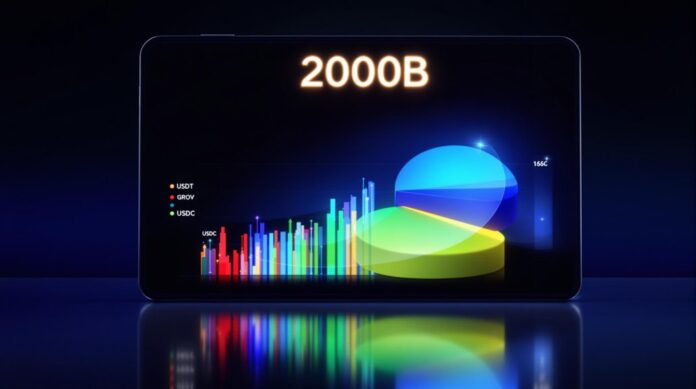We’ve seen a remarkable surge in the stablecoinA cryptocurrency pegged to the value of a stable asset, such market, with its capitalization soaring past $200 billion, reaching $211 billion. This represents a 73% increase since August 2023, mainly driven by USDT’s dominance and USDC’s rising popularity. USDT maintains its lead with a $139.45 billion market capThe total value of a cryptocurrency, calculated as price mul, while USDC’s share has grown to 21.5%. This shift reflects changing investor preferences and the evolving landscape of digital finance. Let’s explore the factors behind this explosive growth and its implications.
The stablecoin market cap has skyrocketed, surpassing $200 billion for the first time and reaching a staggering $211 billion. This milestone represents a 73% increase from August 2023, accelerating growth since Donald Trump’s election. The surge in stablecoin value signals a potential shift in the crypto landscape, as these digital assets now account for roughly 1% of the total U.S. dollar supply. Stablecoin supply grew over 59% in 2024, reaching 1% of the U.S. dollar supply but lost 13.5% in weight within the total crypto market cap.
We’re witnessing a remarkable transformation in the stablecoin ecosystem. USDT (Tether) remains the dominant player with a $139.45 billion market cap, but USDC is gaining ground rapidly. USDC’s market share has jumped from 18.4% to 21.5%, showcasing its growing popularity among investors and traders. Interestingly, a newcomer, USDe (Ethena), has emerged as the third-largest stablecoin, experiencing an astounding 40-fold growth.
The distribution of stablecoins across blockchainA decentralized ledger that records transactions across a ne networks is evolving. While Ethereum and Tron still host 83% of the stablecoin market cap, we’re seeing a shift in the landscape. Ethereum’s stablecoin market cap grew by an impressive 65% in 2024, while Tron’s increased by 19%. Significantly, networks like Solana, Arbitrum, Base, and Aptos are gaining market share, indicating a diversification of the stablecoin ecosystem.
The impact of stablecoins on the broader financial landscape can’t be overstated. In 2024, the annual stablecoin transfer volumeThe total quantity of cryptocurrency traded within a specifi reached a mind-boggling $27.6 trillion, surpassing the combined volume of Visa and Mastercard by 7.68%. This statistic alone demonstrates the growing importance of stablecoins in global finance.
We’re also observing fascinating trends in stablecoin usage. Surprisingly, 70% of stablecoin transaction volume in 2024 was related to bot activity, highlighting the increasing automation in crypto trading. Additionally, yield-bearing stablecoins now account for over 3% of the market, offering new opportunities for investors seeking returns in the stablecoin space.
Looking ahead, the future of stablecoins appears bright. Experts predict the market cap could double to $400 billion in 2025. This growth is likely driven by increased adoption, regulatory clarity, and the development of new use cases for stablecoins.
As we navigate this evolving landscape, it’s clear that stablecoins are becoming an integral part of the global financial system. Their ability to provide stability in the volatile crypto market and their efficiency in cross-border transactions positions them as a vital bridge between traditional finance and the digital asset world.
We’re witnessing a financial revolution, and stablecoins are at the forefront of this transformation. As innovation continues to drive the market forward, we can expect stablecoins to play an increasingly significant role in shaping the future of finance.



